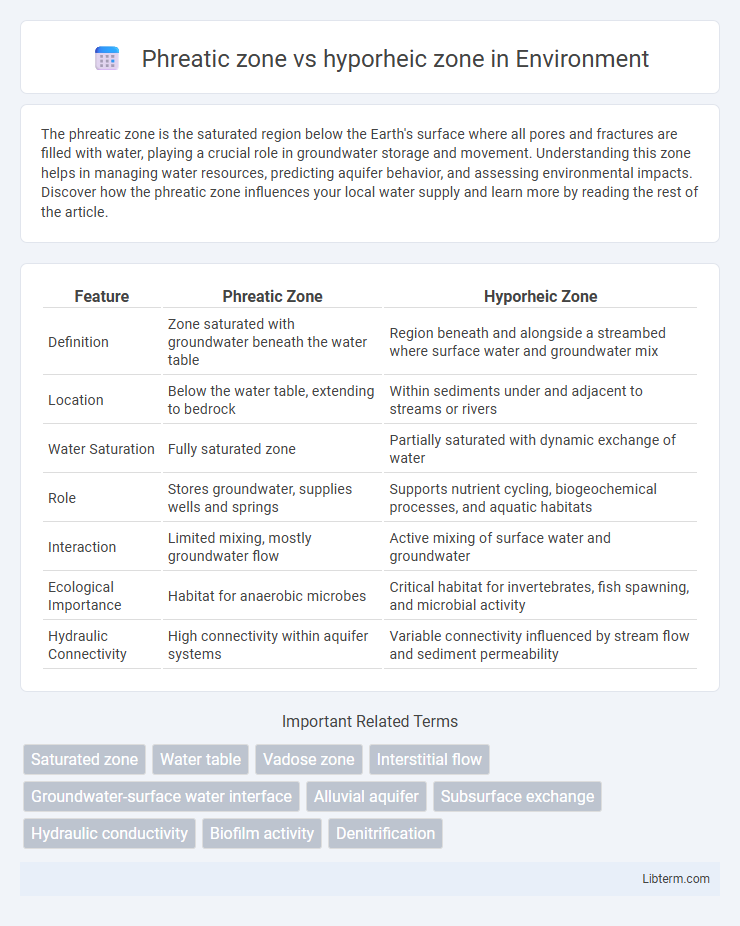The phreatic zone is the saturated region below the Earth's surface where all pores and fractures are filled with water, playing a crucial role in groundwater storage and movement. Understanding this zone helps in managing water resources, predicting aquifer behavior, and assessing environmental impacts. Discover how the phreatic zone influences your local water supply and learn more by reading the rest of the article.
Table of Comparison
| Feature | Phreatic Zone | Hyporheic Zone |
|---|---|---|
| Definition | Zone saturated with groundwater beneath the water table | Region beneath and alongside a streambed where surface water and groundwater mix |
| Location | Below the water table, extending to bedrock | Within sediments under and adjacent to streams or rivers |
| Water Saturation | Fully saturated zone | Partially saturated with dynamic exchange of water |
| Role | Stores groundwater, supplies wells and springs | Supports nutrient cycling, biogeochemical processes, and aquatic habitats |
| Interaction | Limited mixing, mostly groundwater flow | Active mixing of surface water and groundwater |
| Ecological Importance | Habitat for anaerobic microbes | Critical habitat for invertebrates, fish spawning, and microbial activity |
| Hydraulic Connectivity | High connectivity within aquifer systems | Variable connectivity influenced by stream flow and sediment permeability |
Introduction to Subsurface Water Zones
The phreatic zone, also known as the saturated zone, is the subsurface area where all soil pores and rock fractures are fully filled with groundwater, lying below the water table. The hyporheic zone is a dynamic interface between surface water in streams or rivers and groundwater in sediments, characterized by mixing and exchange of water resources. Understanding the distinctions and interactions between the phreatic and hyporheic zones is crucial for managing groundwater recharge, aquatic ecosystems, and contaminant transport in subsurface water systems.
Defining the Phreatic Zone
The phreatic zone refers to the saturated region beneath the Earth's surface where all soil pores and rock fractures are completely filled with groundwater, distinguishing it from the hyporheic zone, which is the interface between surface water and groundwater in streambeds. This saturated zone plays a critical role in aquifer recharge and groundwater flow dynamics. Understanding the phreatic zone is essential for accurate groundwater management and modeling subsurface hydrology.
Understanding the Hyporheic Zone
The hyporheic zone is a dynamic subsurface area beneath and alongside streambeds where surface water and groundwater mix, supporting unique biogeochemical processes crucial for nutrient cycling and habitat diversity. This zone contrasts with the phreatic zone, which is the saturated groundwater zone below the water table, lacking the same ecological interactions found in hyporheic regions. Understanding the hyporheic zone is essential for managing freshwater ecosystems, as it influences water quality, temperature regulation, and aquatic life sustainability.
Key Differences Between Phreatic and Hyporheic Zones
The phreatic zone refers to the saturated groundwater region below the water table where all pores are filled with water, while the hyporheic zone is the subsurface area beneath and alongside a stream bed where surface water and groundwater mix. Key differences include their hydrological connectivity, with the phreatic zone representing stable groundwater storage and the hyporheic zone acting as a dynamic interface facilitating nutrient exchange and ecological processes. The hyporheic zone typically influences stream temperature and biogeochemical cycles, whereas the phreatic zone primarily contributes to baseflow and groundwater recharge.
Hydrological Processes in Each Zone
The phreatic zone, also known as the saturated zone, plays a crucial role in groundwater flow and storage, characterized by fully saturated porous media that facilitate vertical and lateral water movement. The hyporheic zone, located beneath and alongside streambeds, supports dynamic exchange between surface water and groundwater, driving biogeochemical processes and influencing nutrient cycling. Hydrological processes in the hyporheic zone enhance stream ecology through filtration and temporary storage, while the phreatic zone primarily controls baseflow and aquifer recharge.
Ecological Roles of the Phreatic Zone
The phreatic zone serves as a critical groundwater reservoir, sustaining baseflow in rivers and wetlands, which supports aquatic habitats during dry periods. This saturated zone influences nutrient cycling and organic matter decomposition, creating stable conditions for subterranean biodiversity, including specialized microbes and invertebrates. Its interaction with surface water regulates the hydrological connectivity essential for maintaining ecological balance in connected freshwater ecosystems.
Ecological Functions of the Hyporheic Zone
The hyporheic zone plays a crucial ecological role by facilitating nutrient cycling, enhancing organic matter decomposition, and sustaining diverse microbial communities that support aquatic food webs. It acts as a dynamic interface between surface water and groundwater, regulating water quality through biogeochemical processes and providing habitat for invertebrates and juvenile fish. This zone's ecological functions contribute significantly to stream ecosystem health, influencing biodiversity and nutrient retention within freshwater environments.
Importance for Groundwater-Surface Water Interactions
The phreatic zone, characterized by saturated groundwater beneath the water table, plays a crucial role in maintaining base flow to rivers and supporting aquifer recharge, directly influencing groundwater-surface water connectivity. The hyporheic zone, a dynamic region of sediment beneath and alongside streambeds where groundwater and surface water mix, is essential for nutrient cycling, habitat diversity, and thermal regulation in aquatic ecosystems. Understanding the distinct functions of these zones enhances water resource management and ecosystem conservation in riverine environments.
Human Impacts on Phreatic and Hyporheic Zones
Human activities such as groundwater extraction, urban development, and agricultural runoff significantly alter the phreatic zone by lowering water tables and contaminating aquifers, disrupting natural hydrological processes. The hyporheic zone experiences impacts from river channelization, pollution, and sedimentation, which reduce habitat quality and impair nutrient cycling between surface water and groundwater. These disturbances compromise ecosystem services like water purification, aquatic habitat support, and flood regulation in both zones.
Conclusion: Integrating Knowledge for Water Resource Management
Integrating knowledge of the phreatic zone and hyporheic zone enhances water resource management by improving groundwater recharge estimates and predicting stream-aquifer interactions. Understanding the distinct hydrological processes in these zones supports sustainable water extraction and ecosystem conservation. Effective management strategies rely on combined data from both zones to balance water availability with environmental health.
Phreatic zone Infographic

 libterm.com
libterm.com